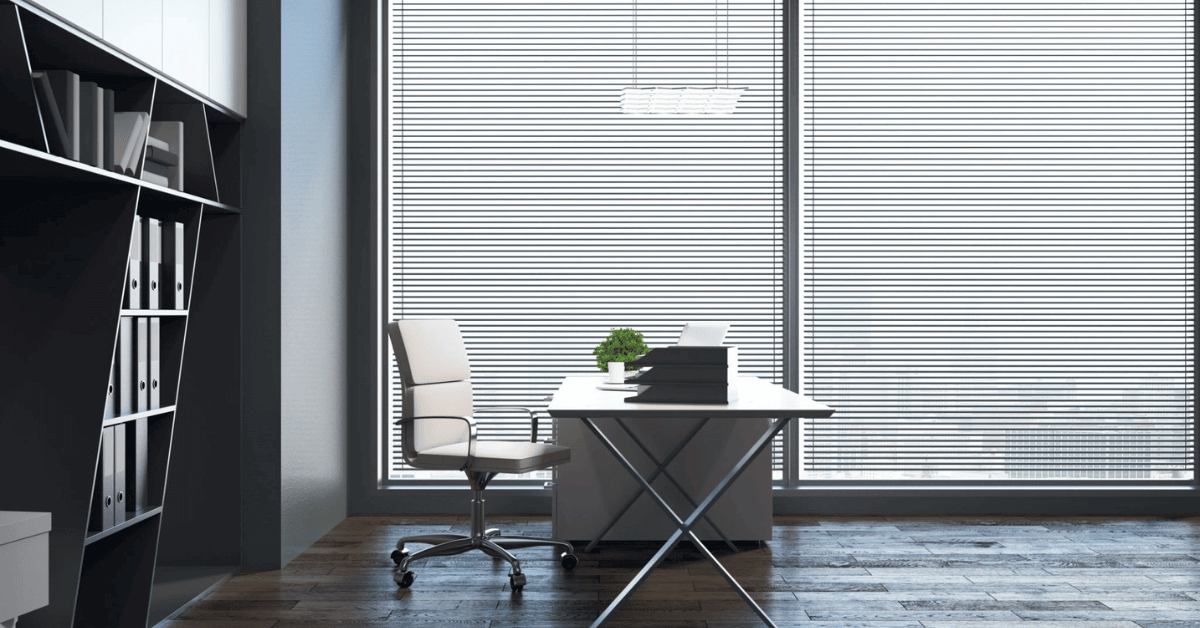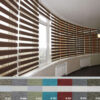
When shopping for blinds, you will likely have come across one of the most essential decisions: Vertical or horizontal blinds. It’s not just about aesthetics but also about functionality and ambiance, and the decision is not as simple as it may seem at first glance.
Several factors are beyond personal preference, such as room size, decor style and practical utility. The significance of making the right choice is shown in how blinds play a crucial role in regulating light, ensuring privacy, and enhancing the overall atmosphere of a room.
This blog post will dive into the nuances of vertical blinds and horizontal blinds, weighing their benefits and drawbacks. Join us as we explore the key features, compare their functionalities, and provide insights to help you make an informed decision and answer the question: Vertical Blinds vs. Horizontal Blinds: Which One Is Better?
Understanding Vertical Blinds
Definition and Characteristics of Vertical Blinds
Vertical blinds are characterized by vertically hanging slats that can be adjusted to control light and privacy levels. These window blinds that open sideways are typically made of fabric, vinyl, or PVC materials, offering a range of options to suit various preferences and practical needs.
Pros of Vertical Blinds
One notable pro of vertical blinds lies in their versatility and customization capabilities. These blinds are well-suited for large windows or sliding glass doors, providing a seamless and elegant solution for expansive openings. The ability to tilt the slats offers precise control over light and privacy, making them an ideal choice for spaces where these factors are paramount. Maintenance and cleaning are relatively straightforward, with many vertical blinds being dust-resistant and easy to clean.
Cons of Vertical Blinds
However, it’s essential to consider the limitations of vertical blinds. While they excel in functionality, their styles and aesthetics may be perceived as somewhat limited compared to their horizontal counterparts. Additionally, over time, potential issues with noise and wear may arise, especially in high-traffic areas.
Considerations for Choosing Vertical Blinds
When choosing vertical blinds, it’s crucial to weigh the pros and cons against your specific needs and preferences. Selecting suitable material, colour, and design can mitigate potential drawbacks, ensuring that vertical blinds enhance both the practical and visual aspects of your living or working space.
Understanding Horizontal Blinds
Definition and Characteristics of Horizontal Blinds
Horizontal blinds are a classic and widely used window treatment and are defined by their horizontally arranged slats that can be tilted to regulate light and privacy. These blinds come in various materials, including wood, faux wood, aluminum, and vinyl, offering a diverse range of options to suit different styles and budgets.
Pros of Horizontal Blinds
One of the critical advantages of horizontal blinds lies in their aesthetics and design options. They seamlessly integrate with various interior styles, from traditional to contemporary, and the array of materials allows for a customized look. Affordability and widespread availability are additional pros of horizontal blinds. With options fitting various budget ranges, these blinds provide a cost-effective solution without compromising style or functionality. Controlling light and privacy is a notable benefit, as horizontal blinds allow for precise adjustments to suit different times of the day or activities.
Cons of Horizontal Blinds
However, it’s essential to know the potential challenges associated with horizontal blinds. Maintenance and cleaning can be more involved, especially for materials susceptible to dust and grime. While horizontal blinds are versatile in many scenarios, they may have limitations in specific window configurations or sizes.
Considerations for Choosing Horizontal Blinds
When choosing horizontal blinds, consider the maintenance requirements and ensure that the design complements your overall decor, balancing functionality and visual appeal.
Factors to Consider When Choosing Blinds
When considering the decision-making process of choosing blinds for your space, several key factors come into play to ensure a harmonious blend of functionality and style.
Room-Specific Considerations
Each room in your home has unique requirements, and selecting blinds tailored to these needs is crucial.
- Living Room: Consider blinds that enhance the room’s aesthetics while allowing for flexible light control during social gatherings or movie nights.
- Bedroom: Opt for blinds prioritizing privacy and light-blocking capabilities to create a comfortable and restful sleeping environment.
- Kitchen: Choose blinds that can withstand moisture and are easy to clean, as kitchens often experience high humidity levels and potential splatters.
Material and Durability
The material of your blinds impacts both their longevity and aesthetic appeal. Consider factors such as moisture resistance, ease of cleaning, and durability when selecting materials like wood, faux wood, aluminum, vinyl, or fabric.
Budget Considerations
Blinds come in a range of price points. Establish a budget early in the process to narrow down your options and find blinds that meet both your financial constraints and functional requirements, especially if you have to furnish several windows.
Style and Aesthetic Preferences
Blinds contribute significantly to the overall look of a room. Whether you lean towards the classic appeal of horizontal blinds, the modern vibe of vertical blinds, or the natural warmth of wooden blinds, align your choice with your style preferences and the existing decor of the space.
Comparing Vertical and Horizontal Blinds
Head-to-Head Comparison of Key Features
| Vertical Blinds | Horizontal Blinds | |
| Light Control | Excellent light control, especially for large windows and sliding glass doors. The ability to tilt the slats allows for precise adjustments, managing sunlight effectively. | Provide reasonable light control, with the option to tilt the slats. However, it may be less effective for very large windows or doors. |
| Privacy | Well-suited for maintaining privacy, especially in rooms with expansive windows. Tilt the slats to control the view from outside effectively. | Offer good privacy control when slats are angled appropriately. It may have limitations for large openings. |
| Maintenance | Generally easy to maintain, with dust-resistant materials. Cleaning involves simple wiping or vacuuming. | May require more effort to clean, especially for dust-prone materials. Regular dusting and occasional deep cleaning may be necessary. |
| Aesthetics | Modern and sleek, suitable for contemporary spaces. Ideal for rooms with high ceilings or unique architectural features. | Classic and versatile, fitting various interior styles. Particularly complementary in traditional or mid-century modern settings. |
Real-Life Scenarios: When to Choose Vertical or Horizontal Blinds
Choose Vertical Blinds When:
– Dealing with large windows or sliding glass doors.
– Emphasizing a modern and sleek aesthetic.
– Prioritizing versatility in light control for expansive spaces.
Choose Horizontal Blinds When:
– Working with standard-sized windows or smaller openings.
– Seeking a classic and versatile look that complements various decor styles.
– Considering budget constraints, as horizontal blinds often offer affordable options.
Conclusion
Choosing between vertical and horizontal blinds involves carefully considering key features impacting functionality and aesthetics.
Vertical blinds are great for managing light for large openings, while horizontal blinds offer effective control for standard-sized windows. Both options provide privacy, but vertical blinds are particularly well-suited for expansive windows and sliding doors, while vertical blinds are generally easier to maintain with dust-resistant materials. Vertical blinds bring a modern and sleek look, whereas horizontal blinds offer a classic and versatile appeal.
Choose vertical blinds when dealing with large windows or sliding glass doors and/or look for a modern aesthetic and versatility in light control.
On the other hand, horizontal blinds are ahead when working with standard-sized windows or on a budget or if you prefer a classic and adaptable style.
The key to selecting the perfect blinds lies in aligning your choices with the specific needs and aesthetics of each room. By weighing factors such as room size, style preferences, and budget constraints, you can make an informed decision that enhances both the functionality and visual appeal of your living space.
For those seeking a reliable and competitive solution, look no further than Sky Blinds. With over 20 years of experience in the industry, we have established ourselves as a trusted name in providing top-notch window coverings. Our commitment to excellence is evident in our HomeStars verification, assuring exceptional service and customer satisfaction every time. When you choose Sky Blinds, you choose quality craftsmanship, innovative design, and superior functionality.
Whether you are looking for vertical blinds or horizontal blinds, all of our products are uniquely crafted to enhance your space while providing optimal light control and privacy. Whether you prefer a sleek modern look or a timeless classic style, our extensive range of customizable options ensures you’ll find the perfect fit for your home or office.
Schedule a free consultation with Sky Blinds today by calling 416-876-4759 or filling out our convenient online form. Your journey to elevated living starts here.
Frequently Asked Questions
What is the Cost Difference Between Vertical and Horizontal Blinds?
One of the biggest concerns is the vertical vs. horizontal blinds cost The cost varies based on factors like material, size, and brand. Generally, horizontal blinds are often more budget-friendly than vertical blinds.
Should I Choose Vertical or Horizontal Blinds for Privacy?
Both vertical and horizontal blinds offer privacy control. Vertical blinds are ideal for large openings, while horizontal blinds are effective for standard-sized windows.
Which Type of Blinds is Recommended for Bedrooms?
When looking at vertical or horizontal blinds for your bedroom, both vertical and horizontal blinds can work. Horizontal blinds generally provide a bit more privacy. Consider factors like window size, style preferences, and light control needs when making a decision.
Can You Mix Vertical and Horizontal Blinds in the Same Room?
Yes, mixing vertical and horizontal blinds can create a unique and stylish look. Ensure that the overall aesthetic is cohesive and complements the room’s design.






